Role of autophagy and ferroptosis in the development of endometriotic cysts (Review)
- Authors:
- Hiroshi Kobayashi
- Shogo Imanaka
- Chiharu Yoshimoto
- Sho Matsubara
- Hiroshi Shigetomi
-
Affiliations: Department of Gynecology and Reproductive Medicine, Ms.Clinic MayOne, Kashihara, Nara 634‑0813, Japan, Department of Obstetrics and Gynecology, Nara Medical University, Kashihara, Nara 634‑8522, Japan - Published online on: July 11, 2024 https://doi.org/10.3892/ijmm.2024.5402
- Article Number: 78
-
Copyright: © Kobayashi et al. This is an open access article distributed under the terms of Creative Commons Attribution License.
This article is mentioned in:
Abstract
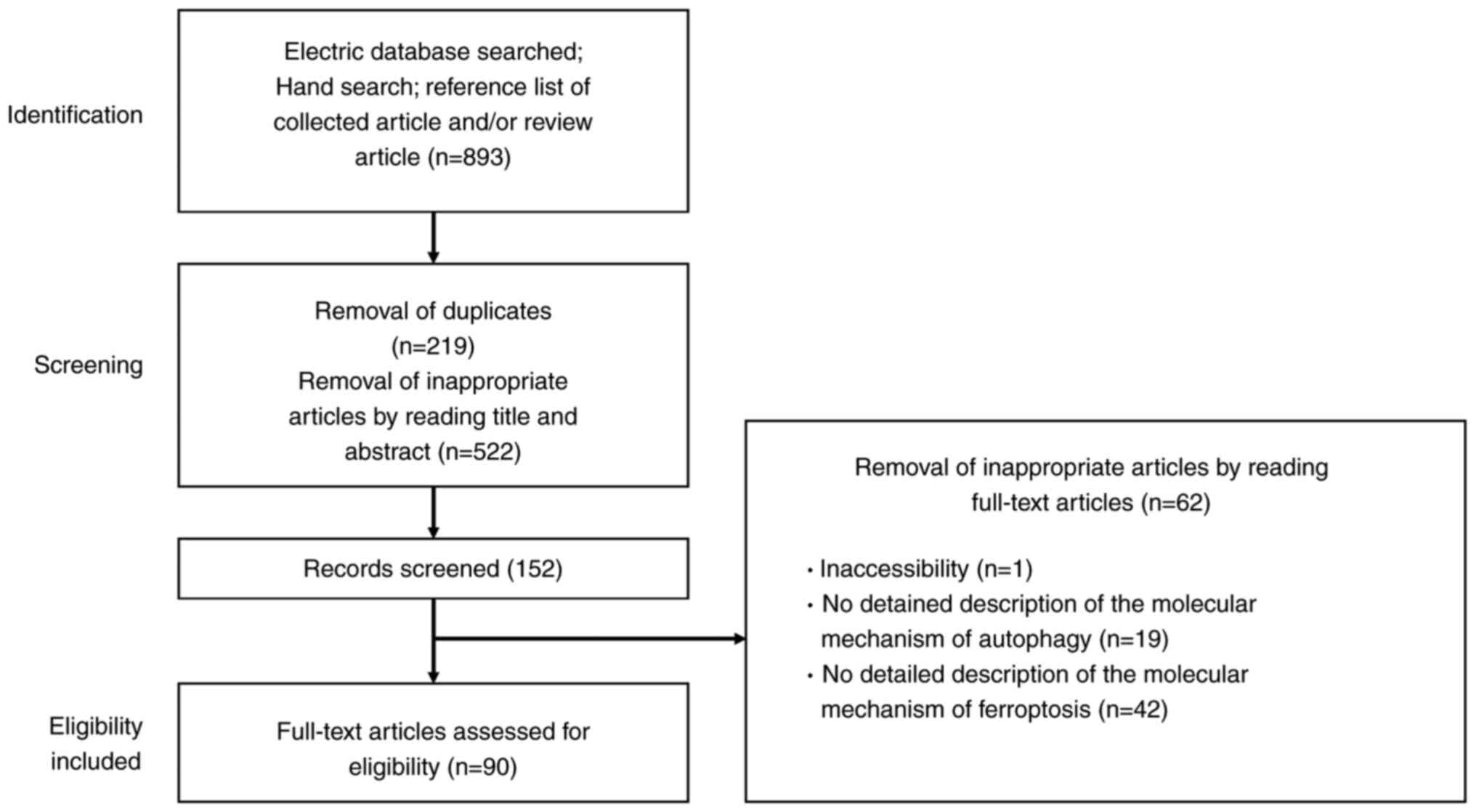 |
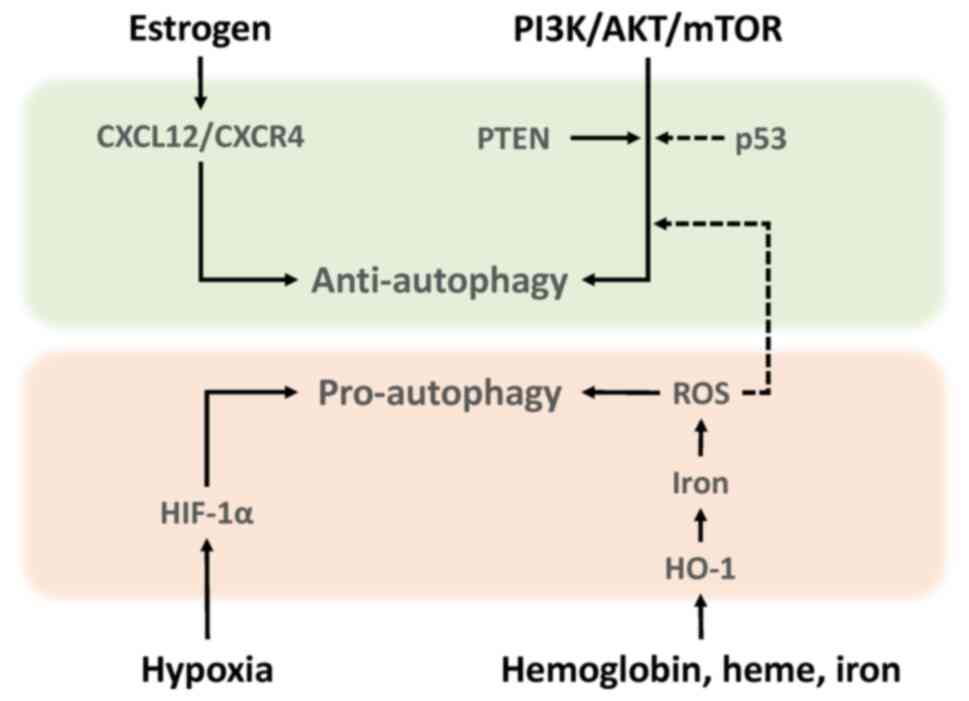 |
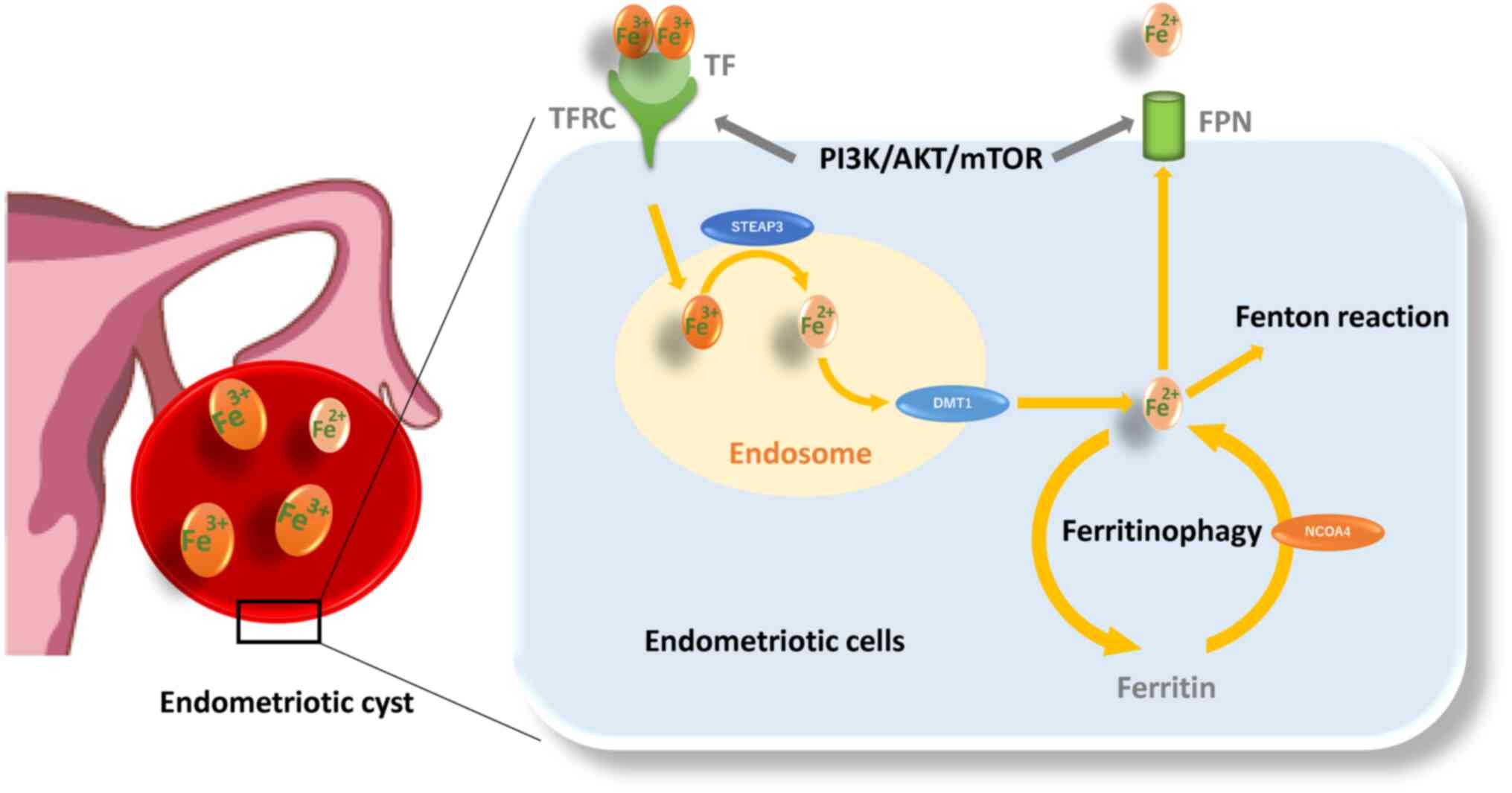 |
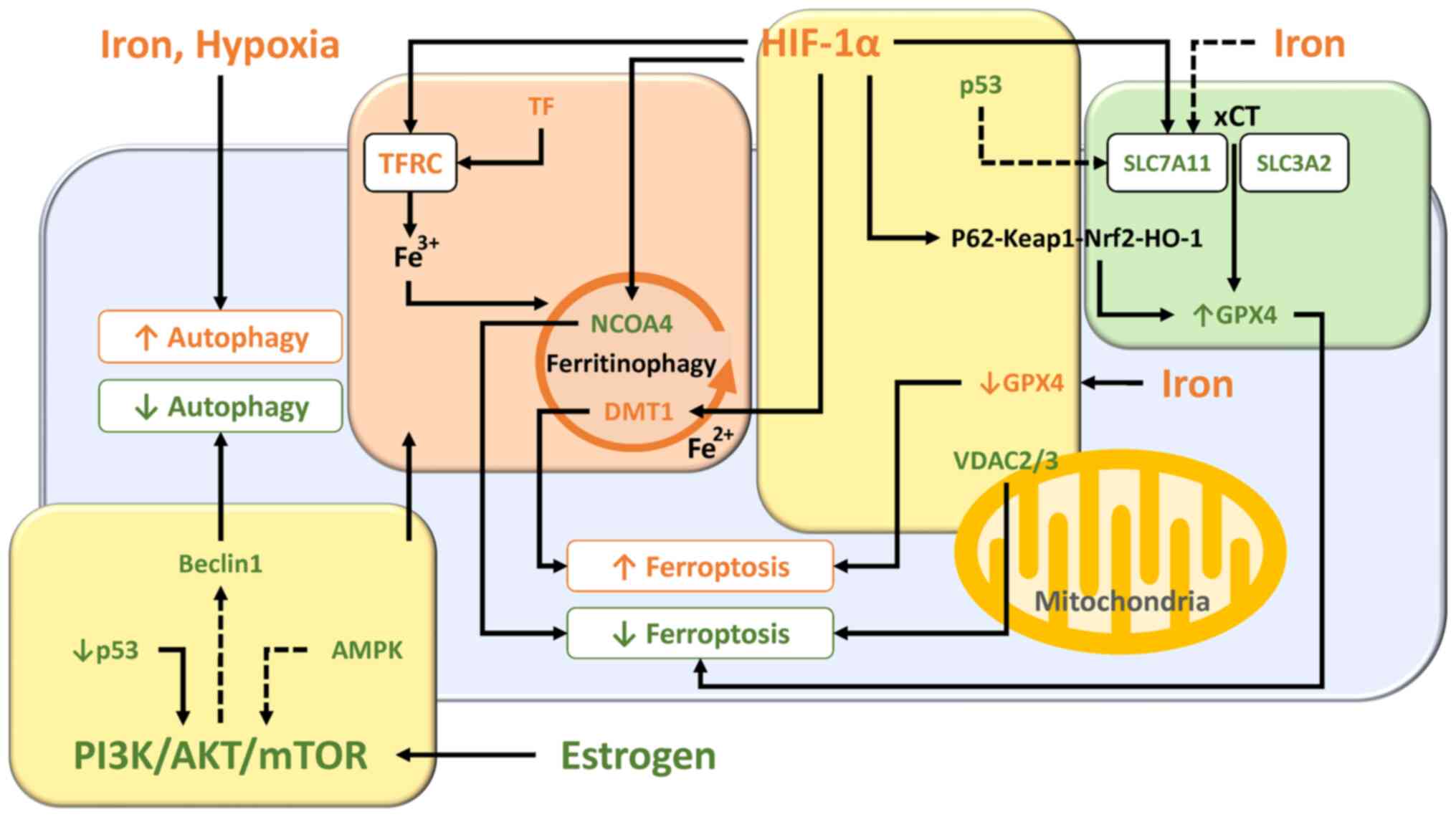 |
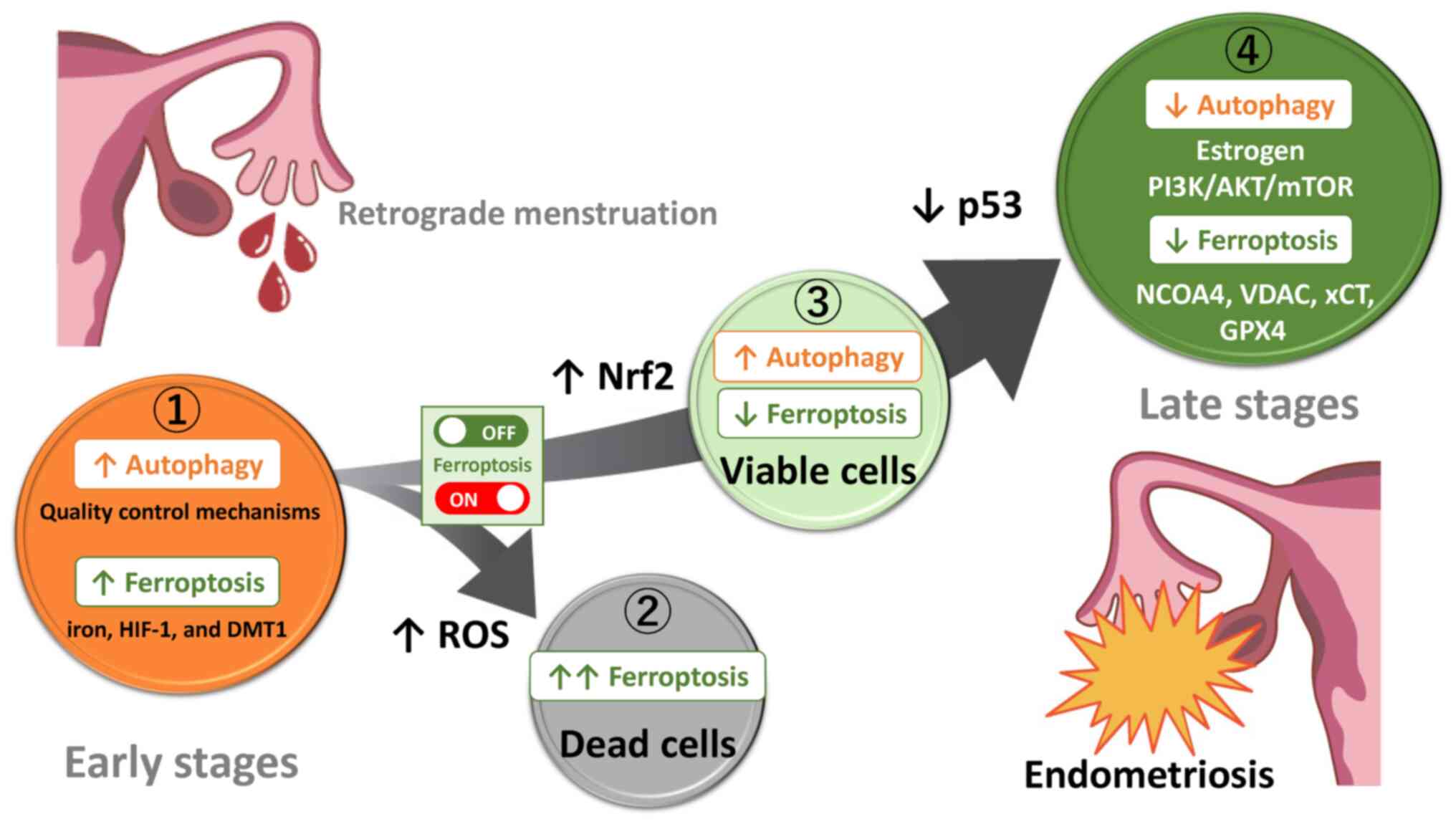 |
|
Giudice LC: Clinical practice. Endometriosis. N Engl J Med. 362:2389–2398. 2010. View Article : Google Scholar : PubMed/NCBI | |
|
Vinatier D, Orazi G, Cosson M and Dufour P: Theories of endometriosis. Eur J Obstet Gynecol Reprod Biol. 96:21–34. 2001. View Article : Google Scholar : PubMed/NCBI | |
|
Sampson JA: Peritoneal endometriosis due to the menstrual dissemination of endometrial tissue into the peritoneal cavity. Am J Obstet Gynecol. 14:422–469. 1927. View Article : Google Scholar | |
|
Li WN, Wu MH and Tsai SJ: Hypoxia and reproductive health: The role of hypoxia in the development and progression of endometriosis. Reproduction. 161:F19–F31. 2021. View Article : Google Scholar | |
|
Scutiero G, Iannone P, Bernardi G, Bonaccorsi G, Spadaro S, Volta CA, Greco P and Nappi L: Oxidative stress and endometriosis: A systematic review of the literature. Oxid Med Cell Longev. 2017:72652382017. View Article : Google Scholar : PubMed/NCBI | |
|
Viganò P, Parazzini F, Somigliana E and Vercellini P: Endometriosis: Epidemiology and aetiological factors. Best Pract Res Clin Obstet Gynaecol. 18:177–200. 2004. View Article : Google Scholar : PubMed/NCBI | |
|
Huang E, Wang X and Chen L: Regulated cell death in endometriosis. Biomolecules. 14:1422024. View Article : Google Scholar : PubMed/NCBI | |
|
Yang HL, Mei J, Chang KK, Zhou WJ, Huang LQ and Li MQ: Autophagy in endometriosis. Am J Transl Res. 9:4707–4725. 2017.PubMed/NCBI | |
|
Feng Y, He D, Yao Z and Klionsky DJ: The machinery of macroautophagy. Cell Res. 24:24–41. 2014. View Article : Google Scholar : | |
|
Lee S, Hwang N, Seok BG, Lee S, Lee SJ and Chung SW: Autophagy mediates an amplification loop during ferroptosis. Cell Death Dis. 14:4642023. View Article : Google Scholar : PubMed/NCBI | |
|
Li X, He S and Ma B: Autophagy and autophagy-related proteins in cancer. Mol Cancer. 19:122020. View Article : Google Scholar : PubMed/NCBI | |
|
Glick D, Barth S and Macleod KF: Autophagy: Cellular and molecular mechanisms. J Pathol. 221:3–12. 2010. View Article : Google Scholar : PubMed/NCBI | |
|
Li H, Yang H, Lu S, Wang X, Shi X and Mao P: Autophagy-dependent ferroptosis is involved in the development of endometriosis. Gynecol Endocrinol. 39:22429622023. View Article : Google Scholar : PubMed/NCBI | |
|
Liu J, Kuang F, Kroemer G, Klionsky DJ, Kang R and Tang D: Autophagy-dependent ferroptosis: Machinery and regulation. Cell Chem Biol. 27:420–435. 2020. View Article : Google Scholar : PubMed/NCBI | |
|
Kong Z and Yao T: Role for autophagy-related markers beclin-1 and LC3 in endometriosis. BMC Womens Health. 22:2642022. View Article : Google Scholar : PubMed/NCBI | |
|
Kobayashi H, Imanaka S, Yoshimoto C, Matsubara S and Shigetomi H: Molecular mechanism of autophagy and apoptosis in endometriosis: Current understanding and future research directions. Reprod Med Biol. 23:e125772024. View Article : Google Scholar : PubMed/NCBI | |
|
Mei J, Zhu XY, Jin LP, Duan ZL, Li DJ and Li MQ: Estrogen promotes the survival of human secretory phase endometrial stromal cells via CXCL12/CXCR4 up-regulation-mediated autophagy inhibition. Hum Reprod. 30:1677–1689. 2015. View Article : Google Scholar : PubMed/NCBI | |
|
Shen HH, Zhang T, Yang HL, Lai ZZ, Zhou WJ, Mei J, Shi JW, Zhu R, Xu FY, Li DJ, et al: Ovarian hormones-autophagy-immunity axis in menstruation and endometriosis. Theranostics. 11:3512–3526. 2021. View Article : Google Scholar : PubMed/NCBI | |
|
Guo J, Gao J, Yu X, Luo H, Xiong X and Huang O: Expression of DJ-1 and mTOR in eutopic and ectopic endometria of patients with endometriosis and adenomyosis. Gynecol Obstet Invest. 79:195–200. 2015. View Article : Google Scholar : PubMed/NCBI | |
|
Jamali N, Zal F, Mostafavi-Pour Z, Samare-Najaf M, Poordast T and Dehghanian A: Ameliorative effects of quercetin and metformin and their combination against experimental endometriosis in rats. Reprod Sci. 28:683–692. 2021. View Article : Google Scholar | |
|
Choi J, Jo M, Lee E, Hwang S and Choi D: Aberrant PTEN expression in response to progesterone reduces endometriotic stromal cell apoptosis. Reproduction. 153:11–21. 2017.PubMed/NCBI | |
|
Sato N, Tsunoda H, Nishida M, Morishita Y, Takimoto Y, Kubo T and Noguchi M: Loss of heterozygosity on 10q23.3 and mutation of the tumor suppressor gene PTEN in benign endometrial cyst of the ovary: Possible sequence progression from benign endometrial cyst to endometrioid carcinoma and clear cell carcinoma of the ovary. Cancer Res. 60:7052–7056. 2000. | |
|
Cui D, Qu R, Liu D, Xiong X, Liang T and Zhao Y: The cross talk between p53 and mTOR pathways in response to physiological and genotoxic stresses. Front Cell Dev Biol. 9:7755072021.PubMed/NCBI | |
|
Allavena G, Carrarelli P, Del Bello B, Luisi S, Petraglia F and Maellaro E: Autophagy is upregulated in ovarian endometriosis: A possible interplay with p53 and heme oxygenase-1. Fertil Steril. 103:1244–1251.e1. 2015.PubMed/NCBI | |
|
Bischoff FZ, Heard M and Simpson JL: Somatic DNA alterations in endometriosis: High frequency of chromosome 17 and p53 loss in late-stage endometriosis. J Reprod Immunol. 55:49–64. 2002.PubMed/NCBI | |
|
Poillet-Perez L, Despouy G, Delage-Mourroux R and Boyer-Guittaut M: Interplay between ROS and autophagy in cancer cells, from tumor initiation to cancer therapy. Redox Biol. 4:184–192. 2015.PubMed/NCBI | |
|
Iwabuchi T, Yoshimoto C, Shigetomi H and Kobayashi H: Oxidative stress and antioxidant defense in endometriosis and its malignant transformation. Oxid Med Cell Longev. 2015:8485952015.PubMed/NCBI | |
|
Xu TX, Zhao SZ, Dong M and Yu XR: Hypoxia responsive miR-210 promotes cell survival and autophagy of endometriotic cells in hypoxia. Eur Rev Med Pharmacol Sci. 20:399–406. 2016.PubMed/NCBI | |
|
Liu H, Zhang Z, Xiong W, Zhang L, Xiong Y, Li N, He H, Du Y and Liu Y: Hypoxia-inducible factor-1alpha promotes endometrial stromal cells migration and invasion by upregulating autophagy in endometriosis. Reproduction. 153:809–820. 2017.PubMed/NCBI | |
|
Tsuzuki T, Okada H, Shindoh H, Shimoi K, Nishigaki A and Kanzaki H: Effects of the hypoxia-inducible factor-1 inhibitor echinomycin on vascular endothelial growth factor production and apoptosis in human ectopic endometriotic stromal cells. Gynecol Endocrinol. 32:323–328. 2016. | |
|
McKinnon BD, Kocbek V, Nirgianakis K, Bersinger NA and Mueller MD: Kinase signalling pathways in endometriosis: Potential targets for non-hormonal therapeutics. Hum Reprod Update. 22:382–403. 2016. View Article : Google Scholar : PubMed/NCBI | |
|
Wyatt J, Fernando SM, Powell SG, Hill CJ, Arshad I, Probert C, Ahmed S and Hapangama DK: The role of iron in the pathogenesis of endometriosis: A systematic review. Hum Reprod Open. 2023:hoad0332023. View Article : Google Scholar : PubMed/NCBI | |
|
Hung SW, Zhang R, Tan Z, Chung JPW, Zhang T and Wang CC: Pharmaceuticals targeting signaling pathways of endometriosis as potential new medical treatment: A review. Med Res Rev. 41:2489–2564. 2021. View Article : Google Scholar : PubMed/NCBI | |
|
Zhang M, Xu T, Tong D, Li S, Yu X, Liu B, Jiang L and Liu K: Research advances in endometriosis-related signaling pathways: A review. Biomed Pharmacother. 164:1149092023. View Article : Google Scholar : PubMed/NCBI | |
|
Defrère S, Van Langendonckt A, Vaesen S, Jouret M, González Ramos R, Gonzalez D and Donnez J: Iron overload enhances epithelial cell proliferation in endometriotic lesions induced in a murine model. Hum Reprod. 21:2810–2816. 2006. View Article : Google Scholar : PubMed/NCBI | |
|
Kobayashi H, Shigetomi H and Imanaka S: Nonhormonal therapy for endometriosis based on energy metabolism regulation. Reprod Fertil. 2:C42–C57. 2021. View Article : Google Scholar | |
|
Defrère S, Lousse JC, González-Ramos R, Colette S, Donnez J and Van Langendonckt A: Potential involvement of iron in the pathogenesis of peritoneal endometriosis. Mol Hum Reprod. 14:377–385. 2008. View Article : Google Scholar : PubMed/NCBI | |
|
Sanchez AM, Papaleo E, Corti L, Santambrogio P, Levi S, Viganò P, Candiani M and Panina-Bordignon P: Iron availability is increased in individual human ovarian follicles in close proximity to an endometrioma compared with distal ones. Hum Reprod. 29:577–583. 2014. View Article : Google Scholar : PubMed/NCBI | |
|
Yamaguchi K, Mandai M, Toyokuni S, Hamanishi J, Higuchi T, Takakura K and Sujii S: Contents of endometriotic cysts, especially the high concentration of free iron, are a possible cause of carcinogenesis in the cysts through the iron-induced persistent oxidative stress. Clin Cancer Res. 14:32–40. 2008. View Article : Google Scholar : PubMed/NCBI | |
|
Yoshimoto C, Iwabuchi T, Shigetomi H and Kobayashi H: Cyst fluid iron-related compounds as useful markers to distinguish malignant transformation from benign endometriotic cysts. Cancer Biomark. 15:493–499. 2015. View Article : Google Scholar : PubMed/NCBI | |
|
Iwabuchi T, Yoshimoto C, Shigetomi H and Kobayashi H: Cyst fluid hemoglobin species in endometriosis and its malignant transformation: The role of metallobiology. Oncol Lett. 11:3384–3388. 2016. View Article : Google Scholar : PubMed/NCBI | |
|
Gao G, Li J, Zhang Y and Chang YZ: Cellular iron metabolism and regulation. Adv Exp Med Biol. 1173:21–32. 2019. View Article : Google Scholar : PubMed/NCBI | |
|
Sendamarai AK, Ohgami RS, Fleming MD and Lawrence CM: Structure of the membrane proximal oxidoreductase domain of human Steap3, the dominant ferrireductase of the erythroid transferrin cycle. Proc Natl Acad Sci USA. 105:7410–7415. 2008. View Article : Google Scholar : PubMed/NCBI | |
|
Hou W, Xie Y, Song X, Sun X, Lotze MT, Zeh HJ III, Kang R and Tang D: Autophagy promotes ferroptosis by degradation of ferritin. Autophagy. 12:1425–1428. 2016. View Article : Google Scholar : PubMed/NCBI | |
|
Li Y, Zeng X, Lu D, Yin M, Shan M and Gao Y: Erastin induces ferroptosis via ferroportin-mediated iron accumulation in endometriosis. Hum Reprod. 36:951–964. 2021. View Article : Google Scholar | |
|
Kobayashi H, Yoshimoto C, Matsubara S, Shigetomi H and Imanaka S: Current understanding of and future directions for endometriosis-related infertility research with a focus on ferroptosis. Diagnostics (Basel). 13:19262023. View Article : Google Scholar : PubMed/NCBI | |
|
Matsuzaki S and Schubert B: Oxidative stress status in normal ovarian cortex surrounding ovarian endometriosis. Fertil Steril. 93:2431–2432. 2010. View Article : Google Scholar | |
|
Dai Y, Lin X, Xu W, Lin X, Huang Q, Shi L, Pan Y, Zhang Y, Zhu Y, Li C, et al: MiR-210-3p protects endometriotic cells from oxidative stress-induced cell cycle arrest by targeting BARD1. Cell Death Dis. 10:1442019. View Article : Google Scholar : PubMed/NCBI | |
|
Makker A, Goel MM, Das V and Agarwal A: PI3K-Akt-mTOR and MAPK signaling pathways in polycystic ovarian syndrome, uterine leiomyomas and endometriosis: An update. Gynecol Endocrinol. 28:175–181. 2012. View Article : Google Scholar | |
|
Bayeva M, Khechaduri A, Puig S, Chang HC, Patial S, Blackshear PJ and Ardehali H: mTOR regulates cellular iron homeostasis through tristetraprolin. Cell Metab. 16:645–657. 2012. View Article : Google Scholar : PubMed/NCBI | |
|
Driva TS, Schatz C and Haybaeck J: Endometriosis-associated ovarian carcinomas: How PI3K/AKT/mTOR pathway affects their pathogenesis. Biomolecules. 13:12532023. View Article : Google Scholar : PubMed/NCBI | |
|
Dixon SJ, Lemberg KM, Lamprecht MR, Skouta R, Zaitsev EM, Gleason CE, Patel DN, Bauer AJ, Cantley AM, Yang WS, et al: Ferroptosis: An iron-dependent form of nonapoptotic cell death. Cell. 149:1060–1072. 2012. View Article : Google Scholar : PubMed/NCBI | |
|
Tang D, Chen X, Kang R and Kroemer G: Ferroptosis: Molecular mechanisms and health implications. Cell Res. 31:107–125. 2021. View Article : Google Scholar : | |
|
Li B, Duan H, Wang S and Li Y: Ferroptosis resistance mechanisms in endometriosis for diagnostic model establishment. Reprod Biomed Online. 43:127–138. 2021. View Article : Google Scholar : PubMed/NCBI | |
|
Gao M, Monian P, Quadri N, Ramasamy R and Jiang X: Glutaminolysis and transferrin regulate ferroptosis. Mol Cell. 59:298–308. 2015. View Article : Google Scholar : PubMed/NCBI | |
|
Xu G, Chen L and Li Q: Association of iron metabolism markers, socioeconomic and lifestyle factors with endometriosis: A cross-sectional study. J Trace Elem Med Biol. 78:1271752023. View Article : Google Scholar : PubMed/NCBI | |
|
Mathur SP: Autoimmunity in endometriosis: Relevance to infertility. Am J Reprod Immunol. 44:89–95. 2000. View Article : Google Scholar : PubMed/NCBI | |
|
Santana-Codina N, Gikandi A and Mancias JD: The role of NCOA4-mediated ferritinophagy in ferroptosis. Adv Exp Med Biol. 1301:41–57. 2021. View Article : Google Scholar : PubMed/NCBI | |
|
Alvarado-Díaz CP, Núñez MT, Devoto L and González-Ramos R: Endometrial expression and in vitro modulation of the iron transporter divalent metal transporter-1: Implications for endometriosis. Fertil Steril. 106:393–401. 2016. View Article : Google Scholar | |
|
Stockwell BR, Friedmann Angeli JP, Bayir H, Bush AI, Conrad M, Dixon SJ, Fulda S, Gascón S, Hatzios SK, Kagan VE, et al: Ferroptosis: A regulated cell death nexus linking metabolism, redox biology, and disease. Cell. 171:273–285. 2017. View Article : Google Scholar : PubMed/NCBI | |
|
Gao X, Hu W, Qian D, Bai X, He H, Li L and Sun S: The mechanisms of ferroptosis under hypoxia. Cell Mol Neurobiol. 43:3329–3341. 2023. View Article : Google Scholar : PubMed/NCBI | |
|
Ding J, Zhao Q, Zhou Z, Cheng W, Sun S, Ni Z and Yu C: Huayu jiedu fang protects ovarian function in mouse with endometriosis iron overload by inhibiting ferroptosis. Evid Based Complement Alternat Med. 2022:14068202022. View Article : Google Scholar : PubMed/NCBI | |
|
Ota H, Igarashi S, Kato N and Tanaka T: Aberrant expression of glutathione peroxidase in eutopic and ectopic endometrium in endometriosis and adenomyosis. Fertil Steril. 74:313–318. 2000. View Article : Google Scholar : PubMed/NCBI | |
|
Dodson M, Castro-Portuguez R and Zhang DD: NRF2 plays a critical role in mitigating lipid peroxidation and ferroptosis. Redox Biol. 23:1011072019. View Article : Google Scholar : PubMed/NCBI | |
|
Kapoor R, Sirohi VK, Gupta K and Dwivedi A: Naringenin ameliorates progression of endometriosis by modulating Nrf2/Keap1/HO1 axis and inducing apoptosis in rats. J Nutr Biochem. 70:215–226. 2019. View Article : Google Scholar : PubMed/NCBI | |
|
Ichimura Y, Waguri S, Sou YS, Kageyama S, Hasegawa J, Ishimura R, Saito T, Yang Y, Kouno T, Fukutomi T, et al: Phosphorylation of p62 activates the Keap1-Nrf2 pathway during selective autophagy. Mol Cell. 51:618–631. 2013. View Article : Google Scholar : PubMed/NCBI | |
|
Liu S, Pi J and Zhang Q: Signal amplification in the KEAP1-Nrf2-ARE antioxidant response pathway. Redox Biol. 54:1023892022. View Article : Google Scholar : PubMed/NCBI | |
|
Marcellin L, Santulli P, Chouzenoux S, Cerles O, Nicco C, Dousset B, Pallardy M, Kerdine-Römer S, Just PA, Chapron C and Batteux F: Alteration of Nrf2 and glutamate cysteine ligase expression contribute to lesions growth and fibrogenesis in ectopic endometriosis. Free Radic Biol Med. 110:1–10. 2017. View Article : Google Scholar : PubMed/NCBI | |
|
Loboda A, Damulewicz M, Pyza E, Jozkowicz A and Dulak J: Role of Nrf2/HO-1 system in development, oxidative stress response and diseases: An evolutionarily conserved mechanism. Cell Mol Life Sci. 73:3221–3247. 2016. View Article : Google Scholar : PubMed/NCBI | |
|
Li J, Lu K, Sun F, Tan S, Zhang X, Sheng W, Hao W, Liu M, Lv W and Han W: Panaxydol attenuates ferroptosis against LPS-induced acute lung injury in mice by Keap1-Nrf2/HO-1 pathway. J Transl Med. 19:962021. View Article : Google Scholar : PubMed/NCBI | |
|
Luo L, Huang F, Zhong S, Ding R, Su J and Li X: Astaxanthin attenuates ferroptosis via Keap1-Nrf2/HO-1 signaling pathways in LPS-induced acute lung injury. Life Sci. 311:1210912022. View Article : Google Scholar : PubMed/NCBI | |
|
Ryter SW: Heme oxgenase-1, a cardinal modulator of regulated cell death and inflammation. Cells. 10:5152021. View Article : Google Scholar : PubMed/NCBI | |
|
Machado SE, Spangler D, Stacks DA, Darley-Usmar V, Benavides GA, Xie M, Balla J and Zarjou A: Counteraction of myocardial ferritin heavy chain deficiency by heme oxygenase-1. Int J Mol Sci. 23:83002022. View Article : Google Scholar : PubMed/NCBI | |
|
Lee H, Zandkarimi F, Zhang Y, Meena JK, Kim J, Zhuang L, Tyagi S, Ma L, Westbrook TF, Steinberg GR, et al: Energy-stress-mediated AMPK activation inhibits ferroptosis. Nat Cell Biol. 22:225–234. 2020. View Article : Google Scholar : PubMed/NCBI | |
|
Wang Z, Yao M, Jiang L, Wang L, Yang Y, Wang Q, Qian X, Zhao Y and Qian J: Dexmedetomidine attenuates myocardial ischemia/reperfusion-induced ferroptosis via AMPK/GSK-3β/Nrf2 axis. Biomed Pharmacother. 154:1135722022. View Article : Google Scholar | |
|
Song X, Zhu S, Chen P, Hou W, Wen Q, Liu J, Xie Y, Liu J, Klionsky DJ, Kroemer G, et al: AMPK-mediated BECN1 phosphorylation promotes ferroptosis by directly blocking system Xc-activity. Curr Biol. 28:2388–2399.e5. 2018. View Article : Google Scholar | |
|
Huang J, Chen X and Lv Y: HMGB1 mediated inflammation and autophagy contribute to endometriosis. Front Endocrinol (Lausanne). 12:6166962021. View Article : Google Scholar : PubMed/NCBI | |
|
Sui X, Li Y, Sun Y, Li C, Li X and Zhang G: Expression and significance of autophagy genes LC3, beclin1 and MMP-2 in endometriosis. Exp Ther Med. 16:1958–1962. 2018.PubMed/NCBI | |
|
Zhao Y, Li Y, Zhang R, Wang F, Wang T and Jiao Y: The role of erastin in ferroptosis and its prospects in cancer therapy. Onco Targets Ther. 13:5429–5441. 2020. View Article : Google Scholar : PubMed/NCBI | |
|
Geisler S, Holmström KM, Skujat D, Fiesel FC, Rothfuss OC, Kahle PJ and Springer W: PINK1/Parkin-mediated mitophagy is dependent on VDAC1 and p62/SQSTM1. Nat Cell Biol. 12:119–131. 2010. View Article : Google Scholar : PubMed/NCBI | |
|
Vu NT, Kim M, Stephenson DJ, MacKnight HP and Chalfant CE: Ceramide kinase inhibition drives ferroptosis and sensitivity to cisplatin in mutant KRAS lung cancer by dysregulating VDAC-mediated mitochondria function. Mol Cancer Res. 20:1429–1442. 2022. View Article : Google Scholar : PubMed/NCBI | |
|
Xiong J, Nie M, Fu C, Chai X, Zhang Y, He L and Sun S: Hypoxia enhances HIF1 α transcription activity by upregulating KDM4A and mediating H3K9me3, thus inducing ferroptosis resistance in cervical cancer cells. Stem Cells Int. 2022:16088062022. View Article : Google Scholar | |
|
Chen HY, Xiao ZZ, Ling X, Xu RN, Zhu P and Zheng SY: ELAVL1 is transcriptionally activated by FOXC1 and promotes ferroptosis in myocardial ischemia/reperfusion injury by regulating autophagy. Mol Med. 27:142021. View Article : Google Scholar : PubMed/NCBI | |
|
Wang Y, Zhang L and Zhou X: Activation of Nrf2 signaling protects hypoxia-induced HTR-8/SVneo cells against ferroptosis. J Obstet Gynaecol Res. 47:3797–3806. 2021. View Article : Google Scholar : PubMed/NCBI | |
|
Liu XJ, Lv YF, Cui WZ, Li Y, Liu Y, Xue YT and Dong F: Icariin inhibits hypoxia/reoxygenation-induced ferroptosis of cardiomyocytes via regulation of the Nrf2/HO-1 signaling pathway. FEBS Open Bio. 11:2966–2976. 2021. View Article : Google Scholar : PubMed/NCBI | |
|
Fuhrmann DC, Mondorf A, Beifuß J, Jung M and Brüne B: Hypoxia inhibits ferritinophagy, increases mitochondrial ferritin, and protects from ferroptosis. Redox Biol. 36:1016702020. View Article : Google Scholar : PubMed/NCBI | |
|
Ni S, Yuan Y, Qian Z, Zhong Z, Lv T, Kuang Y and Yu B: Hypoxia inhibits RANKL-induced ferritinophagy and protects osteoclasts from ferroptosis. Free Radic Biol Med. 169:271–282. 2021. View Article : Google Scholar : PubMed/NCBI | |
|
Luis G, Godfroid A, Nishiumi S, Cimino J, Blacher S, Maquoi E, Wery C, Collignon A, Longuespée R, Montero-Ruiz L, et al: Tumor resistance to ferroptosis driven by Stearoyl-CoA desaturase-1 (SCD1) in cancer cells and fatty acid biding protein-4 (FABP4) in tumor microenvironment promote tumor recurrence. Redox Biol. 43:1020062021. View Article : Google Scholar : PubMed/NCBI | |
|
Li W, Xiang Z, Xing Y, Li S and Shi S: Mitochondria bridge HIF signaling and ferroptosis blockage in acute kidney injury. Cell Death Dis. 13:3082022. View Article : Google Scholar : PubMed/NCBI | |
|
Zhan L, Wang W, Zhang Y, Song E, Fan Y and Wei B: Hypoxia-inducible factor-1 alpha: A promising therapeutic target in endometriosis. Biochimie. 123:130–137. 2016. View Article : Google Scholar : PubMed/NCBI | |
|
Xiong W, Zhang L, Xiong Y, Liu H and Liu Y: Hypoxia promotes invasion of endometrial stromal cells via hypoxia-inducible factor 1α upregulation-mediated β-catenin activation in endometriosis. Reprod Sci. 23:531–541. 2016. View Article : Google Scholar | |
|
Kang R, Kroemer G and Tang D: The tumor suppressor protein p53 and the ferroptosis network. Free Radic Biol Med. 133:162–168. 2019. View Article : Google Scholar | |
|
Jiang L, Kon N, Li T, Wang SJ, Su T, Hibshoosh H, Baer R and Gu W: Ferroptosis as a p53-mediated activity during tumour suppression. Nature. 520:57–62. 2015. View Article : Google Scholar : PubMed/NCBI | |
|
Ou Y, Wang SJ, Li D, Chu B and Gu W: Activation of SAT1 engages polyamine metabolism with p53-mediated ferroptotic responses. Proc Natl Acad Sci USA. 113:E6806–E6812. 2016. View Article : Google Scholar : PubMed/NCBI | |
|
Tarangelo A, Magtanong L, Bieging-Rolett KT, Li Y, Ye J, Attardi LD and Dixon SJ: p53 suppresses metabolic stress-induced ferroptosis in cancer cells. Cell Rep. 22:569–575. 2018. View Article : Google Scholar : PubMed/NCBI | |
|
Zou W, Wang X, Xia X, Zhang T, Nie M, Xiong J and Fang X: Resveratrol protected against the development of endometriosis by promoting ferroptosis through miR-21-3p/p53/SLC7A11 signaling pathway. Biochem Biophys Res Commun. 692:1493382024. View Article : Google Scholar | |
|
Sang L, Fang QJ and Zhao XB: A research on the protein expression of p53, p16, and MDM2 in endometriosis. Medicine (Baltimore). 98:e147762019. View Article : Google Scholar : PubMed/NCBI | |
|
Wang X, Zhou L, Dong Z and Wang G: Identification of iron metabolism-related predictive markers of endometriosis and endometriosis-relevant ovarian cancer. Medicine (Baltimore). 102:e334782023. View Article : Google Scholar : PubMed/NCBI | |
|
Goodall M and Thorburn A: Identifying specific receptors for cargo-mediated autophagy. Cell Res. 24:783–784. 2014. View Article : Google Scholar : PubMed/NCBI | |
|
Oh SJ, Ikeda M, Ide T, Hur KY and Lee MS: Mitochondrial event as an ultimate step in ferroptosis. Cell Death Discov. 8:4142022. View Article : Google Scholar : PubMed/NCBI | |
|
Ng SW, Norwitz SG, Taylor HS and Norwitz ER: Endometriosis: The role of iron overload and ferroptosis. Reprod Sci. 27:1383–1390. 2020. View Article : Google Scholar : PubMed/NCBI | |
|
Zhang Y, Liu X, Deng M, Xu C, Zhang Y, Wu D, Tang F, Yang R and Miao J: Ferroptosis induced by iron overload promotes fibrosis in ovarian endometriosis and is related to subpopulations of endometrial stromal cells. Front Pharmacol. 13:9306142022. View Article : Google Scholar : PubMed/NCBI | |
|
Li G, Lin Y, Zhang Y, Gu N, Yang B, Shan S, Liu N, Ouyang J, Yang Y, Sun F and Xu H: Endometrial stromal cell ferroptosis promotes angiogenesis in endometriosis. Cell Death Discov. 8:292022. View Article : Google Scholar : PubMed/NCBI | |
|
Wang X, Wei Y, Wei F and Kuang H: Regulatory mechanism and research progress of ferroptosis in obstetrical and gynecological diseases. Front Cell Dev Biol. 11:11469712023. View Article : Google Scholar : PubMed/NCBI | |
|
Su LJ, Zhang JH, Gomez H, Murugan R, Hong X, Xu D, Jiang F and Peng ZY: Reactive oxygen species-induced lipid peroxidation in apoptosis, autophagy, and ferroptosis. Oxid Med Cell Longev. 2019:50808432019. View Article : Google Scholar : PubMed/NCBI | |
|
Yadav AK, Yadav PK, Chaudhary GR, Tiwari M, Gupta A, Sharma A, Pandey AN, Pandey AK and Chaube SK: Autophagy in hypoxic ovary. Cell Mol Life Sci. 76:3311–3322. 2019. View Article : Google Scholar : PubMed/NCBI |









